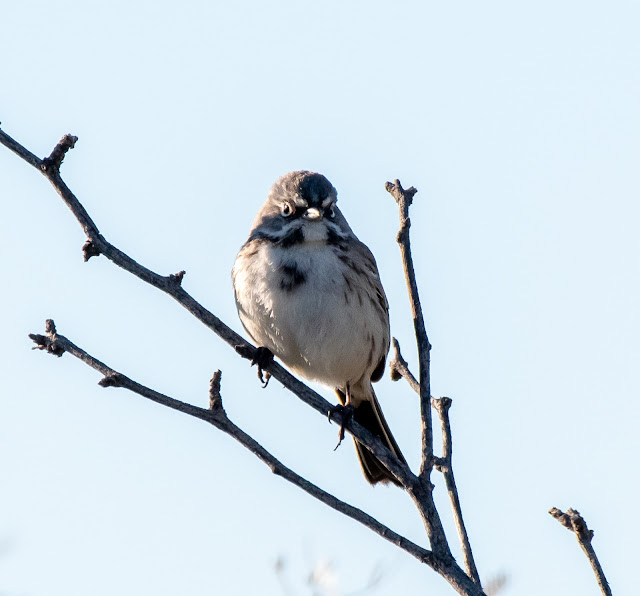The month of February this year is not only a Leap Year month with 29 days, but it has proven to be a great month for me in observing one of the my favorite hummingbirds; the Costa's Hummingbird. When the desert receives some proper rainfall, the Wolfberry (Lycium andersonii) bushes come to life and start blooming. This shrub in bloom is a favorite of hummingbirds with the small lavender blossoms and when they set fruit and it ripens, many other species of birds feed on the berries when they ripen. This winter has been fairly decent in the rainfall department, so it has been fun observing the Anna's and Costa's Hummingbirds fight over feeding rights and defending their territories. These mornings have allowed me to get some fun photos of the Costa's Hummingbirds and a few of the Anna's as well. Below are 3 photos of Costa's males and 3 photos of Costa's females, followed by 2 photos each of Anna's males and females.
Costa's Hummingbird - Male
Sipping nectar from Wolfberry blossoms.
Costa's Hummingbird - Female
Anna's Hummingbird - Male
Anna's Hummingbird - Female
Hummingbirds have kind of been the stars of the show for the month, but they are most definitely the only interesting and great birds that were observed. The one regular Western Screech-Owl that I had been monitoring, turned into two after discovering a second one in a second cavity.
Western Screech-Owl - Number 1
Number 2
One of the biggest highlights for me in February was getting a new yard bird. Glanced up in my neighbor's tree to see a small falcon and at first glance, thought it was just an American Kestrel, which I see almost yearly in the neighborhood. But its posture looked a little odd, so I hurried into the house to grab my binoculars and took a second look and WOW! It was a Merlin! This is a male and it is the 'Prairie' subspecies (richardsonii). What a great bird to add to my yard list.
Merlin - Male
A trip out west of the Phoenix metro area with 3 birding friends allowed me to get some photos of some really good birds that presented themselves well enough to capture a few photos. Bell's Sparrow can sometimes be a bit difficult to to find and identify in the winter due to the fact that we have many more Sagebrush Sparrows and the 2 are not always easy to distinguish one from the other. Plus, I have never really gotten very good photos of Bell's Sparrow. LeConte's Thrasher. What can I say about this bird, except that it is one of the most sought after birds in Maricopa County? And who doesn't like Long-billed Curlews? When a flock flies over, you start clicking away.
Bell's Sparrow
LeConte's Thrasher
Long-billed Curlew
A trip to southeastern Arizona gave me a chance to photograph a Mexican Duck and this post is the first time that I have included it in one of of blog posts since it is now considered a separate species according to Clements list of birds of the world. Hepatic Tanagers and two species of titmouse are nice additions for the month.
Mexican Duck
Hepatic Tanager
Bridled Titmouse
Juniper Titmouse
And finally a few of the desert regulars that I have had the pleasure of seeing in February.
Gambel's Quail - Female
Cactus Wren
Verdin
Black-tailed Gnatcatcher - Male in breeding plumage
Greater Roadrunner
With the milder weather in February a few butterflies are starting to make an appearance. Got to see my first Painted Lady on the first of the month and some lovely Lupine Blues on the fifteenth.
Painted lady
Lupine Blue
Lupine Blue
The month of February was a month of enjoying our fine feathered friends in the Sonoran Desert. Spring migration is just around the corner.

























































